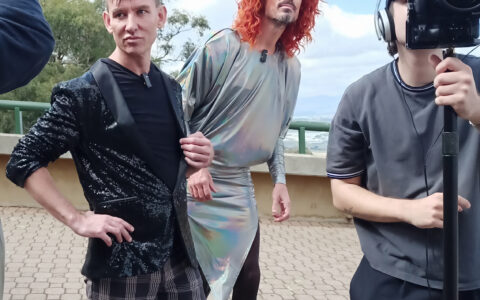SINK
SIMONA CASTRICUM
(DINOSAUR CITY RECORDS)
Small disclosure: I DJed alongside Simona Castricum almost 20 years ago at a queer dance party in Naarm (Melbourne) promoted as an ‘alternative’ to the poppy hi-nrg (meat market) scene. I saw her make the dancefloor deliciously sweaty by mixing grinding techno, acid, electroclash and punky prototypes of the passionate synthpop she’s now lauded for.
Small confession: I missed her live performances during Vivid Sydney 2022 because I was away and I regret it deeply. On the upside, there’s some great footage of her performances online and we now have this new album to enjoy.
I must warn you: SINK is sometimes so deeply intimate it hurts, especially at the start (Lean Into Belonging) and end (Grateful for the Heartache). It’s also hugely expansive, deep, dark club music that will fill any space it’s performed in – like Depeche Mode with a bit of Duran Duran polish – but queerly better.
The fastest way to experience this duality (and the conflicting sensations that come with it) is to head to Simona’s youtube channel and see/hear/feel her perform the album’s final track Grateful for the Heartache in 2021.
“It’s the ghost of you that says it’s true / And it’s the last of you we never knew / It’s the most of you I’m thinking of / And it’s the best of you I’ll always love.”
It’s also really strong during the slow-burn number Catacombs, which features spaced out synths, chunky basslines and laser sharp drums; and the rushing melodies of Chaise (don’t let the name of that track deceive you into reclining – it’s a belter!).
Recordings of Simona’s live shows for SINK are well worth experiencing because the concept was originally created as a theatrical performance in collaboration with visual artist Carla Zimbler for Arts House (then restaged for Vivid and Midsumma) and billed as a ‘percussive and visual exploration of queer spatial production in hostile urban environments’.
During these performances, Simona sang while playing percussion and synths beneath a rotating string curtain sculpture onto which Carla beat-synced a three dimensional lightshow. In other words, they were literally dancing about architecture. The pun of it is that Simona has a PhD in architecture, for which she explored gender non-conforming and queer spatial production through musical communities.
Let that sink in.










